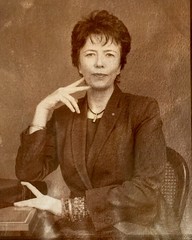Happily given my current interest in typological studies, the Whitechapel Gallery has been hosting a major exhibition by Thomas Struth. Struth studied under Bernd and Hilla Becher in Dusseldorf. Much of his early work could be viewed as typological. His oeuvre spans quite a range from urban landscapes, landscape, portraits, complex images of modern technology and photos of audiences.
Struth’s early work comprised of urban landscapes of streets in New York, Dusseldorf, London and Paris. The initial series went under the name of ‘Unconscious Places’. Formally the images fall into two groups. The first group are street scenes which are captured from a viewpoint in the centre of the road with the compositions emphasising central perspective. The second group have a formal structure which seem to be based on overlapping rectangles/squares. Crosby Street, New York (SoHo) (1978) and Sommerstrasse, Düsseldorf(1980) are examples of the former group.
I have been thinking about what Struth means by ‘unconscious’. Much of what I have read seems to ‘cut and paste’ the same complex and somewhat incomprehensible interpretations. My own view is that Struth was inviting viewers to form their own opinions. I believe that by presenting familiar city scenes without people going through their normal daily social interchange, Struth allows us to look at the spaces themselves. Spaces which have been formed by many influencers over long periods of time. Individuals, builders, local authorities etc etc have all taken decisions and enacted works which have shaped how these streets looked at the time when Struth photographed them. In their day to day routine I doubt if people really ‘see’ the physical environment around them or are conscious of these layers of influence which have collectively created the space. Of course these environments do have an influence on the people within them. So in this sense the spaces are ‘Unconscious Places’. By photographing them Struth has frozen them in time. The photographic medium provides the viewer very detailed representations of the spaces and the opportunity to really look at the them . This process is assisted by the Struth’s typological presentation. The photographs are shown in installations with grids of images, so that we are able to compare and contrast the scenes. This helps us to recognise unique elements and areas of similarity which in turn helps us to interpret the scenes.
Struth’s photos of audiences are particularly ground breaking in my view. His concept was to photograph ‘audiences’ in museums and places of religious significance. His shots have much to say about how people respond to icons of art and religion. He is perhaps questioning our faith in art, religion and indeed popular culture – the latter is depicted by images of Times Square and Las Vegas. It is interesting that in some instances Struth chose to hire extras to serve as his audiences. It demonstates how important it is for him to achieve a strong composition which assists in getting his intention across. Most of these photographs whilst they can be considered a series are very large and have been produced for showing in a gallery. There is a sense of irony about this – making a piece of art about how people respond to art??? . The photograph of the Pantheon in Rome was one of the photographs completed with ‘extras’. The sheer monumentality of the place is magnificently displayed in the very large photograph.
Struth’s Paradise and technology photographs have much in common to my mind. They both present unfathomable systems – on the one hand created by nature (the jungle) and on the other by man (complex systems of wiring/equipment/equations etc). We are left to meditate on these. Perhaps he is commenting on how complex nature and science are. Perhaps he is simply stopping us in our tracks and causing us to think. The fact that the images are impenetrable – blocking our view as it were – forces us to turn our thoughts into ourselves. I must confess sitting in front of Paradise 9 at the exhibition had this kind of effect on me.
Of particular interest to me in view of my thoughts on typological portrait series are Struth’s Family Portraits. This is a series which he has been working on for some time. He has photographs family groups from all over the world. He sets up his camera, decides on the framing he is looking for and then invites the group to arrange themselves within the frame. This dynamic is revealing about the social interactions and etiquette within the families and also by comparing photographs from different countries one also can see national and cultural influences. Struth has said that sometimes allowing the family to organise itself does not result in a pleasing composition – he has been known to ask people to come back and try again in a couple of hours!
Here is the link to the Whitechapel Gallery exhibition.


Posted on August 30, 2011
0